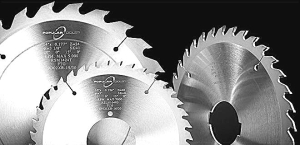Cutting MDF and Plywood
Cutting MDF Compared to Plywood
Both MDF and Plywood can be very tough on the cutting tools. This is why it is important to use saw blades that are specifically designed for cutting MDF and Plywood. Below is a link to some tools specially designed for cutting MDF and Plywood along with some helpful tips on how to choose a saw blade for cutting MDF and Plywood. The rest of this article explains why MDF and Plywood have such a high wear on cutting tools and the differences bewteen the two materials.
Saw Blades for cutting MDF and Plywood
MDF is much harder on tools than plywood is for a variety of reasons.
- The density – especially the varying density (see below)
- The mechanism of separation. Plywood shears while MDF ruptures.
- The amount and kinds of fiber
- The amount of glue and additives used to stretch it.
MDF is harder on cutting tools for several reasons.
- There is just more material being cut. Typically MDF is heavier than plywood because MDF uses wood fibers and then compresses them. (See below)
- Plywood uses peeled wood while MDF can use a variety of fibers some much more abrasive.
- Plywood and MDF can both use the same woods. However in plywood the cells are open or hollow. In MDF the cells have been compressed flat. Cutting hollow a straw is easier than cutting a solid piece of plastic because you can cut the straw one wall at a time.
- The binder is distributed differently in the two materials. In plywood the binder is largely in the overlapping sheets. MDF can be considered binder with particles in it.
In analysis of worn tools we see several things.
- Just the amount of material being cut.
- MDF is more abrasive because it denser. When cutting the fibers are severed but the cut material rubs on the side of the tooth causing wear similar to the effect of a stiff bush versus a soft brush.
- MDF seems to trap more heat in the cut and heat affects the saw tips. Again this is a natural property of the density and the glue distribution.
Suppositions
- It is widely believed that MDF is “grabbier” on cutting tools and tests with ammeters have seemed to confirm this. MDF draws more power than wood or plywood.
- It is widely believed that the glue in MDF is stretched with a clay like binder much as clay is used in paper. This binder is much more abrasive than wood as clay is technically fine sand.
- MDF is made of wood fibers and any source can be used. Although the fibers are broken down into cells they retain many of their base properties. Bamboo cells have different properties than fir cells.
The Materials
Particleboard
This is the generic name for a panel manufactured from lignocellulosic or plant materials. Technically, this is can mean anything from straw or Bagasse (sugarcane stalks) to wood. This material is combined with a synthetic resin or other suitable binder, and then bonded together under heat and pressure. The basic raw materials for particleboard are plant residues or low-quality logs. Some recycled material, where it is economical to use such a substance, is now part of the raw material supply.
MDF, or Medium Density Fiberboard
The same general procedure is employed to manufacture MDF, except that the panels are compressed to a density of 0.50 to 0.80 specific gravity in a hot press by a process in which the entire interfiber bond is created by the added [synthetic resin or other suitable] binder. A wide variety of raw material types can be handled in an MDF plant. These types range from pulp chips to planer shavings to plywood trim to sawdust. Other non-wood materials, such as bagasse, (sugarcane stalks) also make excellent MDF.
Plywood
These panels are made by laying up layers, or plies, of wood so that the grain direction in each ply runs at right angles to the one next to it. Cross-grain construction is what gives plywood its strength and dimensional stability. Standard veneer-core plywood 3/4 in. thick consists of seven plies: two outer veneers, plus five hardwood or softwood plies between them. The layer structure leads to more uniform properties than solid wood, since the effects of grain anisotropy are minimized. The properties of plywood vary with the quality of the constituent layers; typical values are listed below.
Physical Properties
MDF
Modulus of Elasticity of 2500 – 5000 MPa
Modulus of Rupture is from 28 to 80 MPa.
Density of 600-800 kg/m³
Particle board density 160-450 kg/m³
Hardboard (high-density fiberboard) 500-1,450 kg/m³
Color (visual) ……………… Beige
Density ………………………39 lbs./foot³
Internal Bond ……………….90 lbs/inch²
Moisture Content …………..5-8%
Hardness (Shore D)……….45-55
MDF weight 70 90- – 100
Plywood
Tensile Strength, Ultimate 31 MPa 4500 psi parallel to face;
Flexural Modulus 9.3 GPa 1350 ksi 8.2 – 10.3 GPa.
Modulus of rupture in bending is typically 0.06 GPa.
Compressive Yield Strength 31 – 41 MPa 4500 – 5950 psi parallel to face
Shear Modulus 0.17 GPa 24.7 ksi in plane (rolling shear)
Shear Modulus 0.7 GPa 102 ksi through thickness (edgewise shear)
Shear Strength 1.9 MPa 276 psi in plane (rolling shear).
Shear Strength 6.2 MPa 899 psi through thickness (edgewise shear)
Thermal Properties
CTE, linear 20°C 6.1 µm/m-°C 3.39 µin/in-°F
Tags: carbide, MDF, saw blade for cutting plywood, saw blades, woodworking
Leave a Reply




